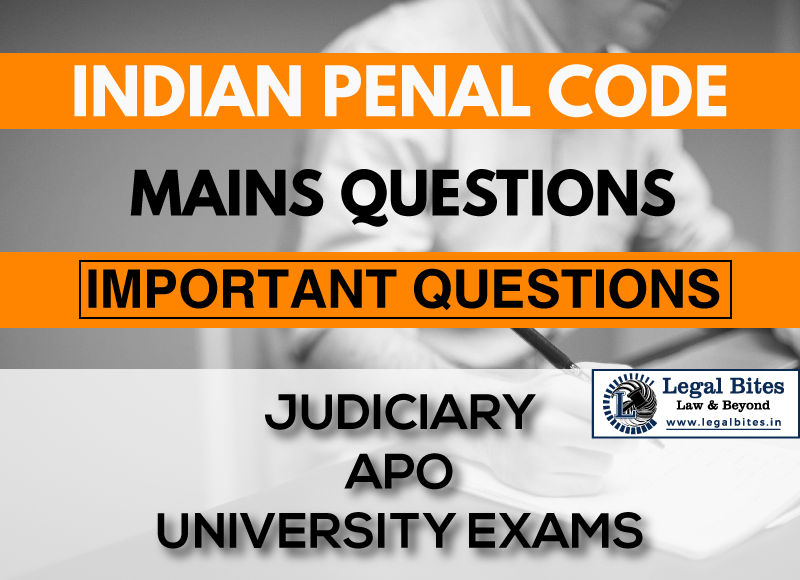The accused A beat the deceased B with a lathi giving her two blows and thereupon deceased B fell down. The lathi blows had not fallen on any vital part of the body…
Question: The accused A beat the deceased B with a lathi giving her two blows and thereupon deceased B fell down. The lathi blows had not fallen on any vital part of the body. A cut the body of B (deceased) in three pieces presuming her to be dead but in fact, she (B) was not dead before… Read More »
;Question: The accused A beat the deceased B with a lathi giving her two blows and thereupon deceased B fell down. The lathi blows had not fallen on any vital part of the body. A cut the body of B (deceased) in three pieces presuming her to be dead but in fact, she (B) was not dead before she was cut by A. Thereafter A buried the pieces of the body of B. Is A guilty of murder or culpable homicide not amounting to murder? Find the answer to the mains question only on Legal Bites [The accused...
Question: The accused A beat the deceased B with a lathi giving her two blows and thereupon deceased B fell down. The lathi blows had not fallen on any vital part of the body. A cut the body of B (deceased) in three pieces presuming her to be dead but in fact, she (B) was not dead before she was cut by A. Thereafter A buried the pieces of the body of B. Is A guilty of murder or culpable homicide not amounting to murder?
Find the answer to the mains question only on Legal Bites [The accused A beat the deceased B with a lathi giving her two blows and thereupon deceased B fell down. The lathi blows had not fallen on any vital part of the body. A cut the body of B (deceased) in three pieces presuming her to be dead but in fact, she (B) was not dead before she was cut by A. Thereafter A buried the pieces of the body of B. Is A guilty of murder or culpable homicide not amounting to murder?]
Answer
Section 300 defines murder, which is also a culpable homicide with some special characteristics, which are set out in cl. 1-4 of section 300, subject to the exceptions given in section 300. If any culpable homicide falls within any of the four clauses in section 300, then it will amount to murder. All other instances of culpable homicide including the ones, which may fall within the exceptions to section 300, will be culpable homicide not amounting to murder.
Section 300. Murder.— Except in the cases hereinafter excepted, culpable homicide is murder, if the act by which the death is caused is done with the intention of causing death, or—
Secondly—If it is done with the intention of causing such bodily injury as the offender knows to be likely to cause the death of the person to whom the harm is caused, or—
Thirdly—If it is done with the intention of causing bodily injury to any person, and the bodily injury intended to be inflicted is sufficient in the ordinary course of nature to cause death, or—
Fourthly—If the person committing the act knows that it is so imminently dangerous that it must, in all probability, cause death or such bodily injury as is likely to cause death, and commits such act without any excuse for incurring the risk of causing death or such injury as aforesaid.
Illustration (c) to section 300: A intentionally gives Z a sword-cut or club-wound sufficient to cause the death of a man in the ordinary course of nature. Z dies in consequence. Here, A is guilty of murder, although he may not have intended to cause Z’s death.
Therefore, as the present facts of the case suggest A is guilty of the murder of B, although he initially may not have intended to cause Z’s death given the actions of A after hitting B with lathi cut the body of B (deceased) in three pieces and buried it clearly shows the intention and knowledge of A what he was doing is homicide. Hence, A is punishable for murder under section 302.
Important Mains Questions Series for Judiciary, APO & University Exams
- IPC Mains Questions Series Part I: Important Questions
- IPC Mains Questions Series Part II: Important Questions
- IPC Mains Questions Series Part III: Important Questions
- IPC Mains Questions Series Part IV: Important Questions
- IPC Mains Questions Series Part V: Important Questions
- IPC Mains Questions Series Part VI: Important Questions
- IPC Mains Questions Series Part VII: Important Questions
- IPC Mains Questions Series Part VIII: Important Questions
- IPC Mains Questions Series Part IX: Important Questions
- IPC Mains Questions Series Part X: Important Questions





